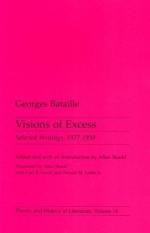|
This section contains 473 words (approx. 2 pages at 400 words per page) |

|
Visions of Excess: Selected Writings, 1927-1939 Summary & Study Guide Description
Visions of Excess: Selected Writings, 1927-1939 Summary & Study Guide includes comprehensive information and analysis to help you understand the book. This study guide contains the following sections:
This detailed literature summary also contains Topics for Discussion and a Free Quiz on Visions of Excess: Selected Writings, 1927-1939 by Georges Bataille.
"Visions of Excess" is written over the years 1927 through 1939 by Georges Bataille. Selected writings are published as a book in 1985. "Visions of Excess" is aptly titled. It is a philosophical study of the surrealist writer's thoughts, ideas and opinions about many different social, economic, and philosophic issues. He records his childhood recollections after undergoing psychoanalysis in "[Dream]" that reveals several underlying themes and psychoses that drive his writing as an adult. His formal training as a medieval librarian provides him with tools of classification and collection to present his eclectic style of communicating with a reading audience. Bataille's written imagery is a verbal equivalent of Salvador Dali's multifaceted "The Lugubrious Game."
Georges Bataille lives from 1897 to 1962, and is a contemporary of philosopher Andre Breton. Born in Reims, France, Georges and his mother abandon his paralytic, blind, and syphilitic father when the Germans arrive there in 1915. Georges rebels against his father by quitting high school and becoming Catholic in 1913. He publishes his first pamphlet in 1918 to honor Cathedral Notre Dame des Reims and his Christian spirit but denies his faith by 1920. Georges writes a book titled "W.C." in 1926 that is "violently opposed to all dignity" and undergoes a psychoanalysis arranged by his friend Dr. Dausse. He writes several other books and founds French reviews titled "Documents", and "Critique." He is a trained medieval librarian and meets Michel Leiris who introduces him to surrealism, but is rejected by Andre Breton, the surrealist leader, who considers Bataille obsessive. Breton calls Bataille an "excremental philosopher" in part because he applies reason to unreasonable things. The style of Bataille's work is often pornographic and repulsive, apparently designed to shock and impact his audience.
"Visions of Excess" is a highly structured and classified book of Bataille's writing over a twelve-year period. Thirty-two articles and essays are categorized in three chronological periods. Many articles have topical subtitles and numerical sections. For example, "The Critique of the Foundations of the Hegelian Dialectic" is in Section II and "Nietzsche and the Fascists" and "The Obelisk" is in Section III. Subtitle subsections vary with Roman and Arabic numerals with no apparent order that range from none to 19, XII, 15 and XIV. There is an apparent benefit provided by structural consistency of tracking the same essay from Introduction to Writing Section and Commentary sections that is diminished when reading the content of an article. Specifically, a reader can follow from the introduction to the essay followed by commentary on it for increased understanding. For example, "[Dream]" is introduced as an obsession that is an animating force in his theory and commented as an episode in his psychoanalysis but written as a three year-old whose "father slaps me and I see the sun." Bataille's "Visions" is a challenging read that leaves one with the question whether his psychoanalysis is yet complete.
Read more from the Study Guide
|
This section contains 473 words (approx. 2 pages at 400 words per page) |

|



